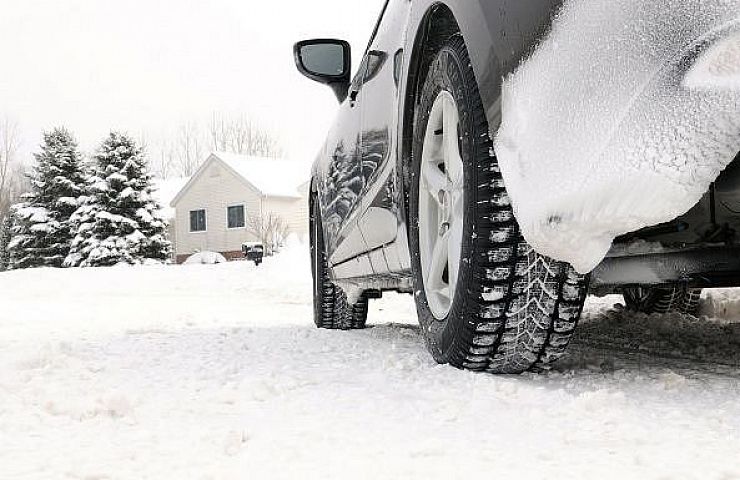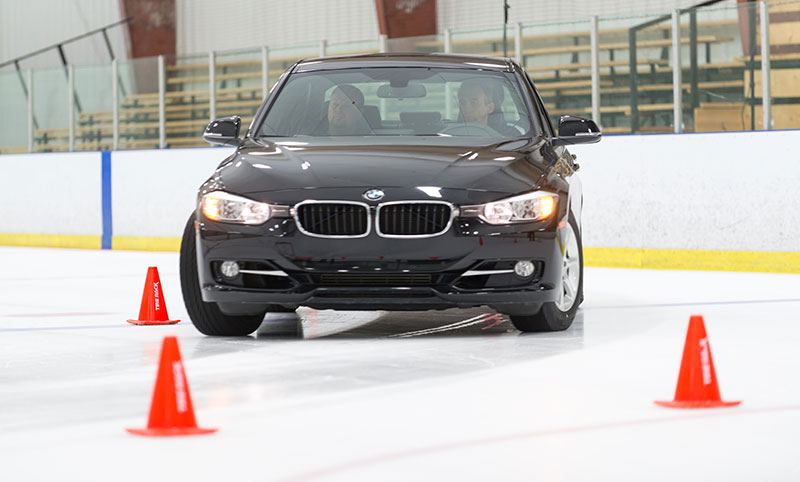If you own a late model sports car, it probably came equipped with summer tires for optimum high-speed performance. Unfortunately when the temperature drops below 40 degrees, the tires become plastic and lose all traction. When this happens, you’ll regret not buying winter tires.
Owners of all-wheel drive cars might think that torque distribution and vectoring features provide adequate traction, but that isn’t the case.
“All-wheel drive cars do a great job of distributing traction for acceleration, almost equivalent to what a winter tire could provide,” explained Matthew Edmonds, executive vice president at The Tire Rack. “The problem is with braking and cornering. The car can only do what the tires make possible.”
Shop now for winter tiresWinter Tires Mean Black Magic
Whereas summer performance tire treads use large tread blocks that make the tire rigid for stability with large grooves to siphon away water, winter tires use smaller blocks with sipes to create additional edges for traction on ice and snow. Sipes are small rubber blades that look like squeegees, and remove water from the road’s surface.

Continental ExtremeWinterContact tires feature high-density sipes to provide multiple gripping edges in an asymmetric tread pattern. They’re molded from a winter rubber compound that remains flexible in freezing temperatures.
In general, a winter tire’s tread pattern will look more aggressive, since its job is to push away snow in order to make contact with the pavement. This requires some fairly big void areas.
Winter tire compounds stay soft in cold temperatures. There’s also what Edmonds calls the “black magic” of compounding: invisible features that give winter tires surprisingly good grip on ice.
The Bridgestone Blizzak is one example. The tire’s rubber compound contains small bubbles that act like Swiss cheese, soaking up the thin layer of water created when a car travels over an ice patch. The ice itself isn’t slippery. But the layer of water created when the tires pass over the surface creates the problem.

Blizzak LM-32 tires have large directional voids (green) for digging through slush and light snow; sipes for added biting edges; and microscopic pores (in the hydrophilic rubber) to wick away the slippery microfilm of water on icy roads.
Winter Performance
Just like summer tires, winter tires come in many varieties. Some, like the Blizzak DM-V2 are designed for areas that see a lot of snow and ice. This isn’t necessarily what owners of high-performance cars are looking for, since they probably won’t be driving those cars when the snow is thigh high.
For these vehicles, the best choice is a winter performance tire such as the Pirelli Sottozero 3, Dunlop Winter Maxx or Michelin X-Ice SNOW. Performance models use compounds that stay soft in temperatures below 40 degrees for improved traction on dry surfaces. The difference is in the tread design, which will have larger blocks closer to what one might find on a summer tire, with fewer sipes.
Stud or Dud?
What about truck and SUV owners who need to make sure that their truck can make it out to plow the street? Are studded tires the answer?
Not necessarily, according to Edmonds.
Vehicle owners need to check legislation in their area, since it varies from state to state. Very few states still allow studded tires, and even those only allow them during a limited time frame.
Edmonds continues:
We have found that the current generation of studless tires actually outperform studded tires on snow and ice. Whereas studded tires depend primarily on the studs to stop the vehicle, studless tires can use the whole surface of the tire, and compounding tends to be more advanced. If the vehicle owner tries to drive on a dry surface with his studded tires, they will be noisy and because the vehicle is riding on metal studs, the tires will not do a good job of stopping the car.
Winter Tires: From Thanksgiving to Tax Day
If you are thinking about investing in a set of winter tires, it’s a good idea to buy an inexpensive set of wheels to mount them on. It will spare your nicer wheels from the ravages of winter and save you the inconvenience of having to dismount one set of tires and mount the other set twice a year. Since dismounting and remounting breaks down the tire beads, this will extend the life of the tires as well.
Shop now for winter tiresWhile generally, winter tire season is Thanksgiving to tax day, drivers in high-altitude areas might need to get moving a little sooner. The snow can fly early in the Rocky Mountains, and when it does, you want to be ready with the right treads on your car or truck.






